Abstract
Background:
Augmentation of an underdeveloped anterior nasal spine (ANS) occidentalizes the Oriental nasal shape. The objective of this study was to investigate the effect of ANS augmentation using an injectable filler, assessing volumetric changes with 3-dimensional images and measuring 2-dimensional images.
Methods:
Forty Japanese patients were treated and evaluated before and after the augmentation. Local anesthetic was injected on the ANS for analgesia. To augment the underdeveloped ANS, approximately 0.5–1.0 ml of calcium hydroxylapatite filler was injected between the medial crura footplates and the ANS. Two-dimensional measurements and superimposable 3-dimensional volumetric assessments were performed pretreatment and 7 days posttreatment. Patients rated their satisfaction using a 5-point scale.
Results:
A significant decrease in nasal width and nostril axis inclination and an increase in nasal tip projection and columellolabial angle were observed by 2-dimensional measurements. Superimposable 3-dimensional color images reinforced the results of the 2-dimensional measurements and showed volumetric soft-tissue changes in the nasal and perinasal areas and the lower cheeks. Ninety percent of the patients were either “satisfied” or “very satisfied” with the results. Posttreatment traction pain and edema resolved in 5 days. Side effects such as hematoma, nodules, and skin necrosis were not observed.
Conclusions:
Objective assessments showed significant effects of this treatment, with good patient satisfaction and minimal levels of discomfort and side effects. Together these results demonstrate that this treatment is safe and effective for Oriental nose occidentalization and perinasal shaping and is also useful for predicting rhinoplasty results.
Nasal augmentation is a common procedure requested by Oriental patients seeking cosmetic procedures to change the nasal appearance from a characteristic flat Oriental nose to a more prominent Occidental nose.1 Among nasal procedures for Oriental patients, augmentation of the nasal dorsum is the most common.
However, compared with the Occidental nose, the characteristic flat Oriental nose has a wider nasal width, a less projected and broader nasal tip, acute columellolabial angle (CLA),2,3 a short columella,4 and an underdeveloped anterior nasal spine (ANS).5,6 As such, to occidentalize the Oriental nose, augmentation of the nasal dorsum is not sufficient. An increase in nasal tip projection and CLA, together with decreased nasal width and nostril axis inclination (NAI, the angle between nostril axes), is essential for Oriental nose occidentalization.
The Oriental nose often has a preexisting acute CLA and an underdeveloped or absent nasal spine.5 Moreover, nasal tip projection achieved through a tip graft or cephalic rotation of the nasal tip may worsen at the retracted columella–labial junction in the Oriental nose with an underdeveloped ANS, and thus, augmentation of an underdeveloped ANS to correct an acute CLA is a more effective approach.5
Although an implant or surgeries are effective for Oriental nose occidentalization, the downtime and potential adverse effects are not well accepted in Japan. Filler rhinoplasty is minimally invasive and has a good safety record while providing immediate and convenient visible results that can potentially help patients who are concerned with the downtime that is generally associated with a surgical intervention.4 Although augmentation of the nasal dorsum using fillers is very popular, the use of fillers to augment an underdeveloped ANS remains uncommon.
In the aging nose, a drooping nasal tip can occur secondary to atrophy of the underlying bone support to produce a relatively prominent dorsal hump.7–9 The Oriental nose deformity, with a less-projected nasal tip and acute CLA, is caused by an underdeveloped ANS and lack of underlying bone support.6 The augmentation of an underdeveloped ANS using an injectable filler between the medial crura and ANS enables convenient and safe Oriental nose occidentalization.6 In addition to the occidentalization, volumetric soft-tissue changes in the middle third of the face and rejuvenation effects on the aging nose with a drooping nasal tip were clinically achieved after ANS augmentation.
One issue in cosmetic clinical studies is the lack of an accurate assessment of the degree of effects. Conventional evaluations using 2-dimensional (2D) color photographs have been widely used in the clinical evaluation of treatments, but these photographs sometimes cannot provide an accurate objective assessment, especially in terms of 3-dimensional (3D) volumetric changes. By comparison, 3D facial images can provide valuable information.10 Superimposable 3D volumetric assessments can evaluate and objectively present the effectiveness of the results and show patient results that are not demonstrable with standard 2D photography.11,12 Therefore, superimposable 3D volumetric assessments were used to objectively evaluate the results in this study.
The objective of the study was to investigate the effects of ANS augmentation with injectable filler using both 2D morphological measurements and superimposable 3D volumetric assessments.
MATERIALS AND METHODS
Japanese Patients
Forty Japanese patients (38 females and 2 males) aged 27–58 years (mean age, 39.6 ± 10.6 years) were enrolled in this study. All patients had visited the Clinica Tanaka Anti-Aging Center to undergo aesthetic treatments. None of the patients had a history of any type of nasal cosmetic treatments. Patients used no specific skin care products. All patients gave written informed consent for participation in the study after reading the experimental protocol and being advised about the risks of treatment.
Injection
A topical anesthetic cream was applied approximately 60 minutes before the injection of local anesthesia. Local anesthesia was injected on the ANS. Patients can observe simulated results of the ANS augmentation before actual filler injection due to the volume of the local anesthesia.
To obtain long-lasting or permanent results, an amalgam of uniform calcium hydroxylapatite particles in an aqueous carboxymethylcellulose carrier gel (Radiesse; Merz Aesthetics, Franksville, Wisc.) was used as a filler. After local anesthesia, approximately 0.5 ml of filler was injected between the footplates of the medial crura and the underdeveloped ANS (Fig. 1). When additional injection is needed, it is recommended to gradually increase the amount of filler injected by 0.1 ml to avoid overcorrection until the desired results are achieved. In this study, the endpoint of the injection was determined by each patient, and the injection points and directions for each additional injection were determined according to the patient’s request. All patients were treated by the same physician.
Fig. 1.
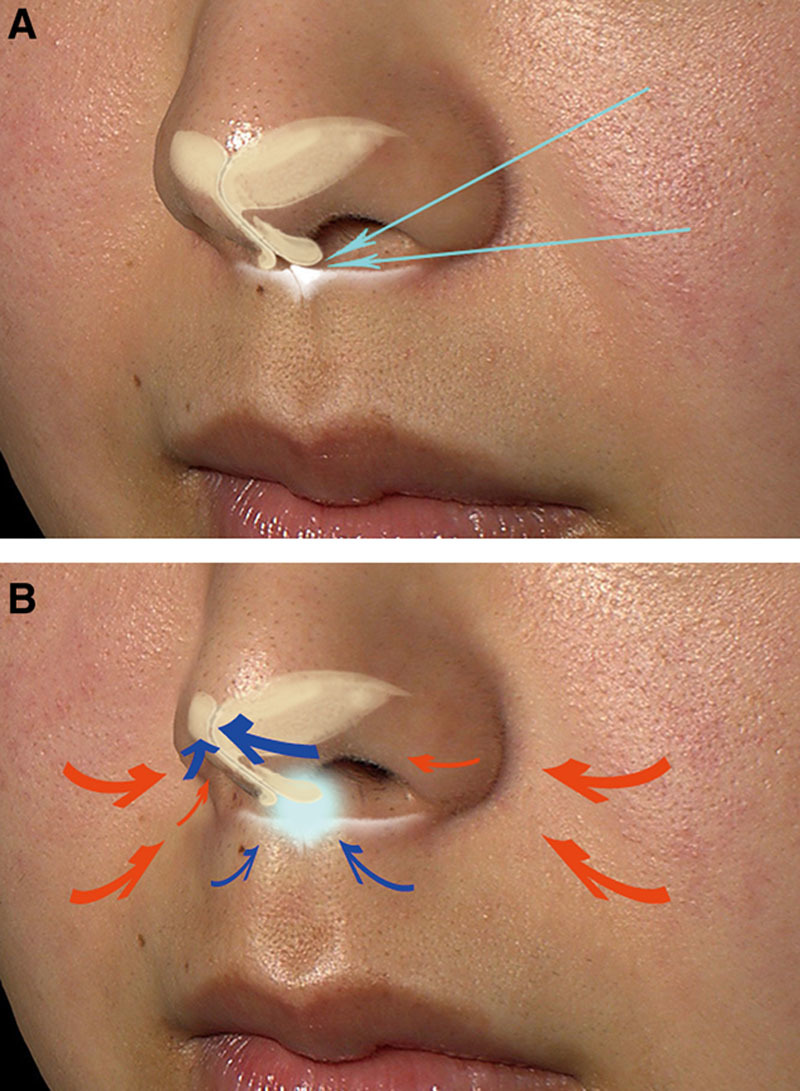
A, Filler was injected between the footplates of the medial crura (beige) and the ANS (white). The injection point and direction are shown by light blue arrows. B, The injected filler (light blue) raised the medial crura forward toward the nasal tip (bold blue arrow) and pulled the cheeks (bold orange arrow) and alars (orange arrow) forward toward the nasal tip, thus enhancing the philtrum (blue arrow). The volumetric increase is shown by blue arrows and volumetric reduction is shown by orange arrows. The schema was drawn on the patients shown in Figure 2.
Objective Assessments
Digital photographs and superimposable 3D imaging were conducted as objective assessments with a Canfield Scientific Vectra camera and software (Canfield Scientific, Fairfield, N.J.). This system is designed to accurately capture the surface shape and 2D color information of the human body. The capture sequence of Vectra was set to less than 3 ms to capture the shape accurately, even if the subject was not perfectly still. Photographs were taken after patients were asked to keep their muscle tone in the resting state, which ensured the same muscle tone in both pretreatment and 7-day posttreatment photographs.
As landmarks to evaluate the nasal shape, we chose the alar (al), which is the most lateral point on each alar contour, and the pronasale (prn), which is the most protruding point of the apex nasi.
To evaluate the effects of the treatment, the morphological nasal width (al-al, distance between the most lateral alar points) was measured. The nasal tip projection was evaluated by a dorsal tip ratio, which was calculated following the definition of 3 points, B (radix), C (prn), and A (projection of C onto the radix-alar line), and determining the ratio: AC/BC. NAI and CLA were also calculated.
Superimposable 3D volumetric assessments indicated the volume changes between pretreatment and posttreatment images and showed the varying degrees of volume reduction in colors ranging from yellow to red. Green areas indicated no changes, whereas blue areas indicated areas that were augmented.
Black and white renderings from an oblique view were also performed to demonstrate and reinforce the volumetric changes after the treatment.
Subjective Assessments
Subjective assessments were performed using questionnaires, in which the patients were asked to rate their degree of satisfaction in terms of results and treatment convenience based on a 5-point scale from 0 to 4 (0 = worse; 1 = little satisfaction or not satisfied; 2 = fairly satisfied; 3 = satisfied; and 4 = very satisfied). Questionnaires were given to patients 7 days posttreatment.
Statistical Analyses
The differences between groups at each time point were examined for statistical significance using the Wilcoxon signed rank test. P < 0.01 was set as a cutoff for statistical significance. The median change and its variability were also illustrated in a box plot graph.
RESULTS
Augmentation of an underdeveloped ANS using an injectable filler between the medial crura and ANS significantly decreased al-al and NAI while increasing nasal tip projection and CLA to achieve occidentalization of the Oriental nose (Figs. 2–4). ANS augmentation also enhanced the philtral columns and affected the overall nasal shape.
Fig. 2.
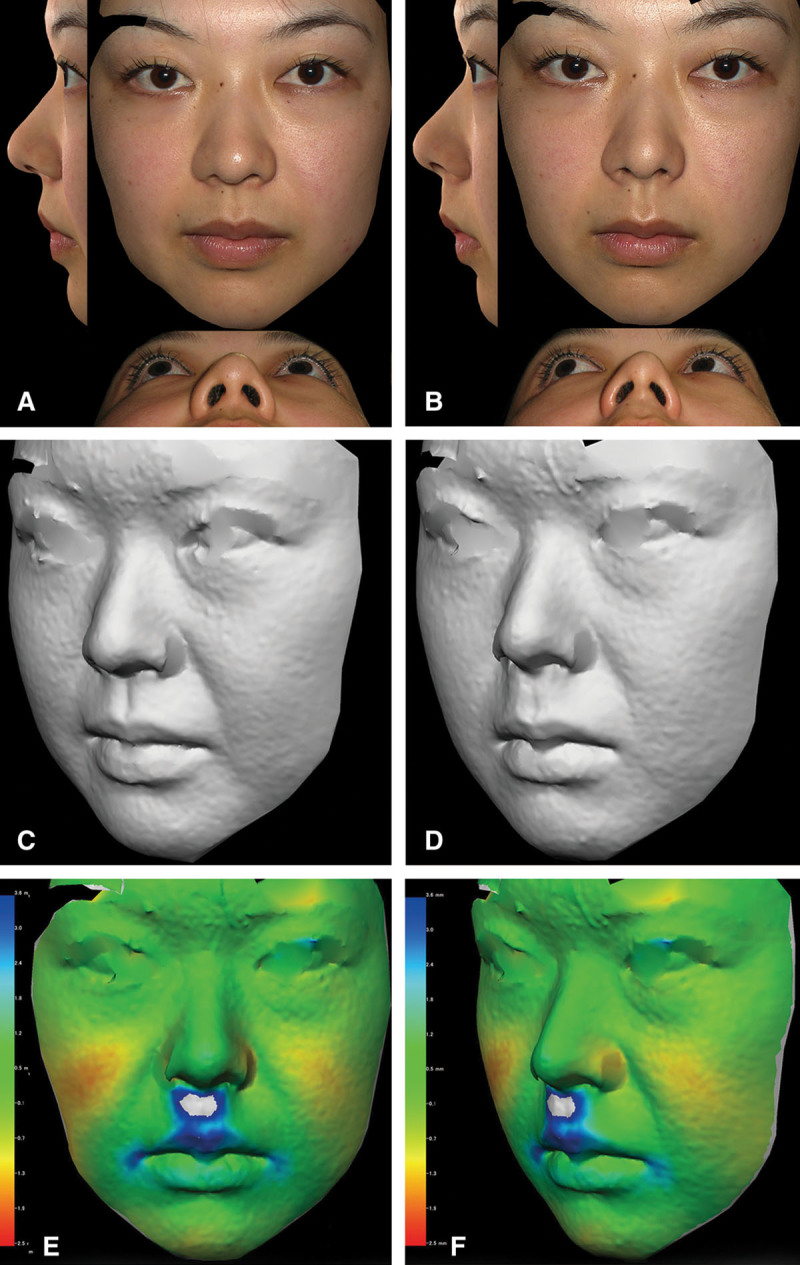
Pretreatment (A and C) and 7-day posttreatment (B and D) photographs (A and B) and black and white renderings from an oblique view (C and D) of a 28-year-old Japanese woman. A total of 0.8-ml filler was injected. Superimposable 3D volumetric assessments (E and F) show volumetric soft-tissue changes in the nasal and perinasal areas and the lower cheeks. The varying degrees of volumetric reduction are shown in colors ranging from yellow to red. Green areas indicate no changes, and blue areas indicate areas that were augmented.
Fig. 4.
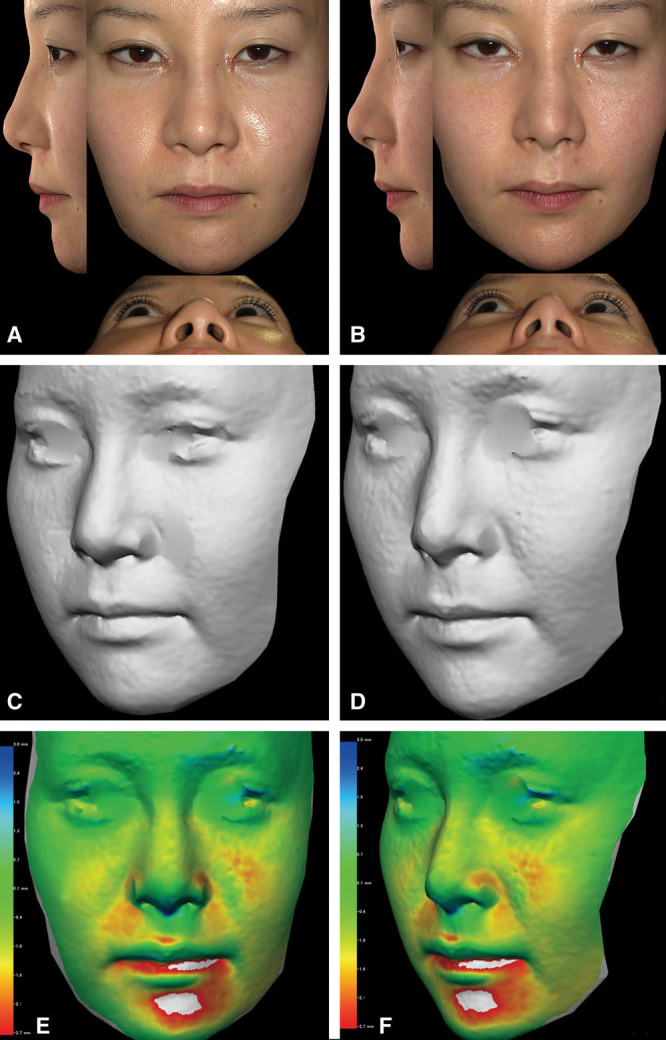
Pretreatment (A and C) and 7-day posttreatment (B and D) photographs (A and B) and black and white renderings from an oblique view (C and D) of a 31-year-old Japanese woman. A total of 0.6-ml filler was injected. Superimposable 3D volumetric assessments (E and F) show volumetric soft-tissue changes in the nasal and perinasal areas and the lower cheeks.
Fig. 3.
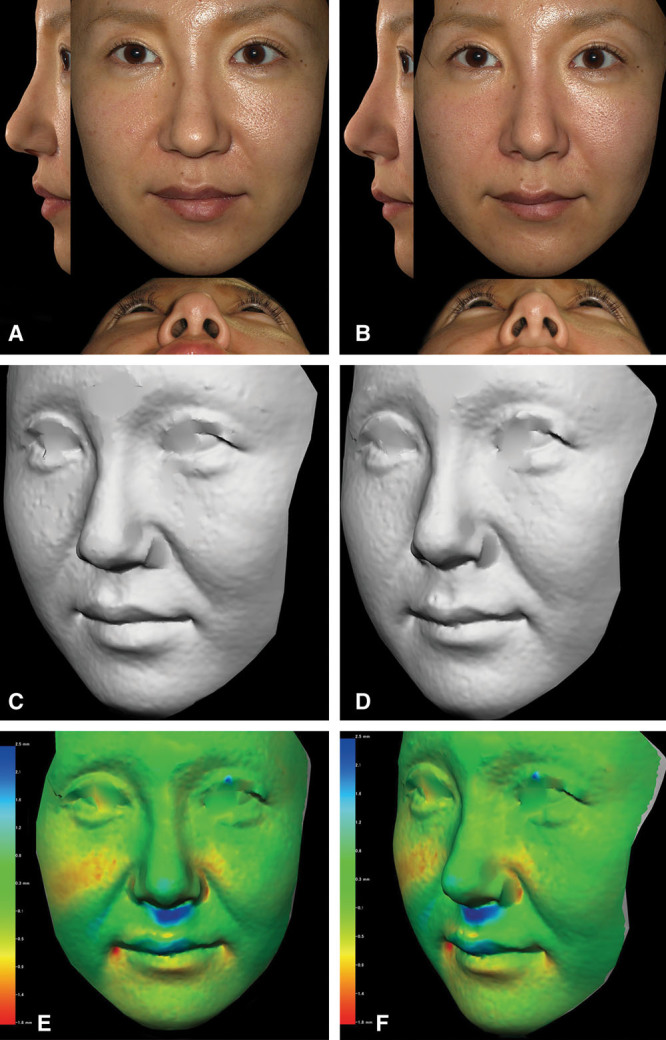
Pretreatment (A and C) and 7-day posttreatment (B and D) photographs (A and B) and black and white renderings from an oblique view (C and D) of a 29-year-old Japanese woman. A total of 0.8-ml filler was injected. Superimposable 3D volumetric assessments (E and F) show volumetric soft-tissue changes in the nasal and perinasal areas and the lower cheeks.
The superimposable 3D color images reinforced the results of 2D measurements and allowed visualization of the lifting effects on the nasal tip, columellar base, and philtrum by illustrating the volumetric increase in all patients and the volumetric reduction that produced slimming effects in the alars and lower cheeks (Figs. 2–4).
Objective assessments with 2D measurements showed significant differences between median pre- and posttreatment scores for al-al, NAI, nasal tip projection, and CLA (P < 0.0001) (Fig. 5).
Fig. 5.
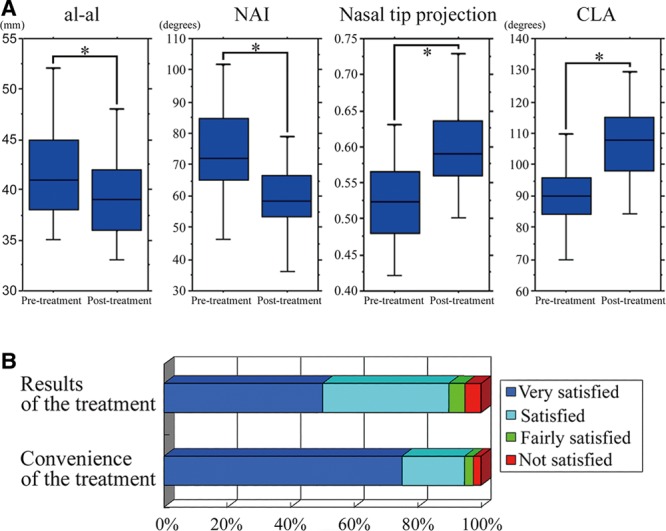
A, The median pre- and posttreatment scores for al-al, NAI, nasal tip projection, and CLA. The box illustrates the interquartile range extending from the 25th to the 75th percentile with a line placed at the median (50th percentile). The bottom and top end of the whiskers show the minimum and maximum data points, respectively. Significant differences (indicated by *) between pre- and posttreatment were observed in all 2D measurements (P < 0.0001). B, Subjective assessments were performed using questionnaires to evaluate the degree of patient satisfaction in terms of treatment results and convenience.
Ninety percent of the patients were either “satisfied” or “very satisfied” with the results. Similarly, 95% of the patients were either “satisfied” or “very satisfied” with the convenience of the treatment (Fig. 5). The mean degrees of satisfaction with the treatment results and convenience based on a 5-point scale from 0 to 4 were 3.38 ± 0.81 and 3.68 ± 0.66, respectively.
Treatments were well tolerated and caused minimal discomfort. Posttreatment traction pain and edema resolved in 5 days. The follow-up period ranged from 1 to 24 months, with an average of 9.25 months. The initially observed changes declined over time because the aqueous carrier gel contained in the filler appeared to be gradually absorbed. Side effects such as hematoma, nodules, and skin necrosis were not observed during the study.
DISCUSSION
Facial rejuvenation has shifted toward less invasive and even nonsurgical procedures that have shorter recovery times and cause less pain.13–15 Soft-tissue augmentation with various soft-tissue filler materials has become one of the most popular aesthetic procedures available to patients who desire nonsurgical facial rejuvenation.14
Although many studies have indicated the efficacy of filler injection to improve facial appearance13,14,16–18 and to perform nonsurgical rhinoplasty,19,20 there are few studies that have investigated Oriental nose occidentalization and volumetric soft-tissue changes following ANS augmentation using an injectable filler. In this study, augmentation of an underdeveloped ANS using an injectable filler significantly decreased al-al and NAI while increasing nasal tip projection and CLA, resulting in occidentalization of the Oriental nose without surgical intervention.
The low nasal tip projection in the Oriental nose may be secondary to an underdeveloped ANS and the drooping nasal tip seen in aging Occident noses. This study confirmed successful Oriental nose occidentalization by filler injection between the medial crura and the underdeveloped ANS. These results suggest that ANS augmentation using an injectable filler may also be able to rejuvenate the drooping nasal tip seen in Occident elders.
Successful rhinoplasty is influenced by nasal tip support of the nasal tip projection.21–25 The medial crura footplates play an important role in nasal tip support.26 In Asians, the alar, and particularly the medial crura cartilage, which is responsible for tip projection, is reported to be thin and weak.27,28
Nasal tip projection can be enhanced by lowering the nasal dorsum, trimming or altering the lower lateral cartilage,29 dividing and everting the lower lateral cartilage,22,30,31 using columellar struts,32,33 tip grafting,24,25,34–36 or replanting the medial crura.23 However, even though augmentation of an underdeveloped ANS in Asians with injectable filler involves no surgical procedures for nasal tip projection and reductions in bulky tissues, in this study, the flat and wide Oriental nasal tip could be sharpened merely by raising the medial crura with filler injection to the ANS. The nasal floors appeared to be secondarily shifted to elongate the columella, resulting in the decreased nasal width, which is similar to Cronin’s method for bilateral cleft lip nose deformity.37
Interestingly, ANS augmentation enhanced the philtral columns and affected the overall nasal shape. The philtrum in the lip has important aesthetic significance and is a mark of individual distinction38 that helps maintain a more youthful periorbital and lip appearance. Youthful lips have full philtral columns that add upper lip–to–nasal base fullness.14 Thus, ANS augmentation with injectable filler can add more structure and support around the philtral columns and can be beneficial for rejuvenation of the upper lip–to–nasal area.
In addition to Oriental nose occidentalization, volumetric soft-tissue changes in the nasal and perinasal areas and the lower cheeks, which may not be sufficiently visible with standard 2D photography, were shown through superimposable 3D volumetric assessments. However, the limitations of 3D photographs are that they can neither fully capture clinical improvements nor distinguish between clinical improvements. As such, changes in facial muscle tone must be considered when interpreting the results. The superimposable 3D color images visualized the volumetric increase in the nasal tip, columellar base, and philtrum, as well as the volumetric reduction in the alars and lower cheeks, that together sharpen the Oriental nose. In younger patients, slimming effects in the cheeks were observed due to the skin and subcutaneous tissue being pulled forward toward the nose, whereas sagging of the skin and subcutaneous tissues prevented slimming of the cheeks in older patients.
Although some augmentation rhinoplasties have been used to camouflage dentoalveolar protrusion,34 these procedures could neither camouflage the ANS position nor improve the CLA. ANS augmentation using an injectable filler could disguise an underdeveloped ANS and improve CLA to approximate Ricketts’ esthetic plane by projecting the nasal tip. The filler injection could also provide support for the medial crus cartilages, resulting in improved nasal tip projection and soft-tissue augmentation of the upper lip and columella base. These findings indicate that even in the Oriental nose, the strut of the medial crura plays an important role in nasal tip projection. Because the Oriental nose is often low, an underdeveloped ANS and a hump nose may also be corrected by advancing the lower one third of the nose instead of performing reduction rhinoplasty on the upper two thirds of the nose.
Ninety percent of the patients in this study were either “satisfied” or “very satisfied” with the results. Treatments were rapid (taking only a few minutes) and well tolerated with minimal discomfort and tissue damage. The patient’s immediate consent and satisfaction were obtained for fine and precise adjustment. Side effects including hematoma, nodules, and skin necrosis were not observed during the study.
The initially observed changes declined over time because the aqueous carrier gel contained in the filler appeared to be gradually absorbed. However, because calcium hydroxylapatite is a permanent type of filler and the augmented volumes with calcium hydroxylapatite remain stable,39 hyaluronic acid fillers would be more suitable for patients who do not desire long-lasting or permanent results.
This simple technique for ANS augmentation using an injectable filler instead of grafts improved the facial aesthetic contour and demonstrated that the strut of the medial crura plays an important role in nasal shape, even in the Oriental nose. Use of fillers also offers an alternative method for projecting the lower one third of the nose.
However, surgical procedures rather than fillers are recommended if the patient presents with some defect, for example, scars, or stiffness of the overlying skin envelope.
CONCLUSIONS
Augmentation of an underdeveloped ANS using an injectable filler between the medial crura and ANS enabled Oriental nose occidentalization. Objective assessments with 2D measurements and superimposable 3D color images showed significant effects produced by this method, which yielded good patient satisfaction and minimal levels of discomfort and side effects. Additionally, superimposable 3D color images showed volumetric reduction in the middle one third of the face, which suggested that augmentation of ANS can rejuvenate this area of the face and occidentalize the Oriental nasal shape.
Together, these results demonstrate that this method is safe and effective for Oriental nose occidentalization and also useful for predicting the results of rhinoplasty or ANS augmentation with a graft or implant.
PATIENT CONSENT
Patients provided written consent for the use of their images.
Footnotes
Disclosure: The authors have no financial interest to declare in relation to the content of this article. The Article Processing Charge was paid for by the authors.
REFERENCES
- 1.Hodgkinson DJ. The Eurasian nose: aesthetic principles and techniques for augmentation of the Asian nose with autogenous grafting. Aesthetic Plast Surg. 2007;31:28–31. doi: 10.1007/s00266-006-0085-9. [DOI] [PubMed] [Google Scholar]
- 2.Leong SC, White PS. A comparison of aesthetic proportions between the Oriental and Caucasian nose. Clin Otolaryngol Allied Sci. 2004;29:672–676. doi: 10.1111/j.1365-2273.2004.00891.x. [DOI] [PubMed] [Google Scholar]
- 3.Han K, Jeong JW, Kim JH, et al. Complete septal extension grafts using porous high-density polyethylene sheets for the westernization of the Asian nose. Plast Reconstr Surg. 2012;130:106e–115e. doi: 10.1097/PRS.0b013e318254b460. [DOI] [PubMed] [Google Scholar]
- 4.Kim P, Ahn JT. Structured nonsurgical Asian rhinoplasty. Aesthetic Plast Surg. 2012;36:698–703. doi: 10.1007/s00266-012-9869-2. [DOI] [PubMed] [Google Scholar]
- 5.Park HS. Lambda-shaped implant for augmentation of anterior nasal spine in Asian rhinoplasty as an ancillary procedure. Aesthetic Plast Surg. 2001;25:8–14. doi: 10.1007/s002660010086. [DOI] [PubMed] [Google Scholar]
- 6.Tanaka Y, Matsuo K, Yuzuriha S. Westernization of the Asian nose by augmentation of the retropositioned anterior nasal spine with an injectable filler. Eplasty. 2011;11:e7. [PMC free article] [PubMed] [Google Scholar]
- 7.Rohrich RJ, Hollier LH. Rhinoplasty with advancing age. Characteristics and management. Clin Plast Surg. 1996;23:281–296. [PubMed] [Google Scholar]
- 8.Rohrich RJ, Hollier LH, Jr, Janis JE, et al. Rhinoplasty with advancing age. Plast Reconstr Surg. 2004;114:1936–1944. doi: 10.1097/01.prs.0000143308.48146.0a. [DOI] [PubMed] [Google Scholar]
- 9.Bartlett SP, Grossman R, Whitaker LA. Age-related changes of the craniofacial skeleton: an anthropometric and histologic analysis. Plast Reconstr Surg. 1992;90:592–600. doi: 10.1097/00006534-199210000-00007. [DOI] [PubMed] [Google Scholar]
- 10.Kim JH, Jung DJ, Kim HS, et al. Analysis of the development of the nasal septum and measurement of the harvestable septal cartilage in Koreans using three-dimensional facial bone computed tomography scanning. Arch Plast Surg. 2014;41:163–170. doi: 10.5999/aps.2014.41.2.163. [DOI] [PMC free article] [PubMed] [Google Scholar]
- 11.Tanaka Y, Tsunemi Y, Kawashima M, et al. Objective assessment of skin tightening in Asians using a water-filtered near-infrared (1,000-1,800 nm) device with contact-cooling and freezer-stored gel. Clin Cosmet Investig Dermatol. 2013;6:167–176. doi: 10.2147/CCID.S47299. [DOI] [PMC free article] [PubMed] [Google Scholar]
- 12.Tanaka Y, Tsunemi Y, Kawashima M, et al. Treatment of skin laxity using multisource, phase-controlled radiofrequency in Asians: Visualized three-dimensional skin tightening results and increase in elastin density shown through histological investigation. Dermatol Surg. 2014;40:756–762. doi: 10.1111/dsu.0000000000000047. [DOI] [PubMed] [Google Scholar]
- 13.Rohrich RJ, Rios JL, Fagien S. Role of new fillers in facial rejuvenation: a cautious outlook. Plast Reconstr Surg. 2003;112:1899–1902. doi: 10.1097/01.PRS.0000097307.62862.27. [DOI] [PubMed] [Google Scholar]
- 14.Rohrich RJ, Ghavami A, Crosby MA. The role of hyaluronic acid fillers (Restylane) in facial cosmetic surgery: review and technical considerations. Plast Reconstr Surg. 2007;120(6 Suppl):41S–54S. doi: 10.1097/01.prs.0000248794.63898.0f. [DOI] [PubMed] [Google Scholar]
- 15.Monstrey SJ, Pitaru S, Hamdi M, et al. A two-stage phase I trial of Evolence30 collagen for soft-tissue contour correction. Plast Reconstr Surg. 2007;120:303–311. doi: 10.1097/01.prs.0000264402.97692.b6. [DOI] [PubMed] [Google Scholar]
- 16.Fagien S, Stuzin J. Injectable soft-tissue augmentation: the present and the future. Plast Reconstr Surg. 2007;120:5S–7S. doi: 10.1097/01.prs.0000248787.57587.d1. [DOI] [PubMed] [Google Scholar]
- 17.Knapp TR, Kaplan EN, Daniels JR. Injectable collagen for soft tissue augmentation. Plast Reconstr Surg. 1977;60:398–405. [PubMed] [Google Scholar]
- 18.Nicolle FV. Correction of age- and disease-related contour deficiencies of the face. Aesthetic Plast Surg. 1985;9:159–162. doi: 10.1007/BF01570350. [DOI] [PubMed] [Google Scholar]
- 19.Jasin ME. Nonsurgical rhinoplasty using dermal fillers. Facial Plast Surg Clin North Am. 2013;21:241–252. doi: 10.1016/j.fsc.2013.02.004. [DOI] [PubMed] [Google Scholar]
- 20.Kurkjian TJ, Ahmad J, Rohrich RJ. Soft-tissue fillers in rhinoplasty. Plast Reconstr Surg. 2014;133:121e–126e. doi: 10.1097/01.prs.0000437246.61294.33. [DOI] [PubMed] [Google Scholar]
- 21.Adams WP, Jr, Rohrich RJ, Hollier LH, et al. Anatomic basis and clinical implications for nasal tip support in open versus closed rhinoplasty. Plast Reconstr Surg. 1999;103:255–261. doi: 10.1097/00006534-199901000-00040. [DOI] [PubMed] [Google Scholar]
- 22.McLure TC. A modified Goldman nasal tip procedure for the drooping nasal tip. Plast Reconstr Surg. 1991;87:254–260. doi: 10.1097/00006534-199102000-00006. [DOI] [PubMed] [Google Scholar]
- 23.Hugo NE, Mattson-Gates G, Sultan MR. Unhooking the hook: sculpting the nasal tip by replanting the medial crura. Plast Reconstr Surg. 1993;91:1344–1348. [PubMed] [Google Scholar]
- 24.Peck GC, Jr, Michelson L, Segal J, et al. An 18-year experience with the umbrella graft in rhinoplasty. Plast Reconstr Surg. 1998;102:2158–2165. doi: 10.1097/00006534-199811000-00056. [DOI] [PubMed] [Google Scholar]
- 25.Menick FJ. Anatomic reconstruction of the nasal tip cartilages in secondary and reconstructive rhinoplasty. Plast Reconstr Surg. 1999;104:2187–2198; discussion 2199–2201. doi: 10.1097/00006534-199912000-00037. [DOI] [PubMed] [Google Scholar]
- 26.Guyuron B. Footplates of the medial crura. Plast Reconstr Surg. 1998;101:1359–1363. doi: 10.1097/00006534-199804050-00035. [DOI] [PubMed] [Google Scholar]
- 27.Dhong ES, Han SK, Lee CH, et al. Anthropometric study of alar cartilage in Asians. Ann Plast Surg. 2002;48:386–391. doi: 10.1097/00000637-200204000-00009. [DOI] [PubMed] [Google Scholar]
- 28.Matory WE, Jr, Falces E. Non-Caucasian rhinoplasty: a 16-year experience. Plast Reconstr Surg. 1986;77:239–252. doi: 10.1097/00006534-198602000-00011. [DOI] [PubMed] [Google Scholar]
- 29.Kridel RW, Konior RJ, Shumrick KA, et al. Advances in nasal tip surgery. The lateral crural steal. Arch Otolaryngol Head Neck Surg. 1989;115:1206. doi: 10.1001/archotol.1989.01860340060018. [DOI] [PubMed] [Google Scholar]
- 30.Goldman IB. The importance of the mesial crura in nasal-tip reconstruction. AMA Arch Otolaryngol. 1957;65:143. doi: 10.1001/archotol.1957.03830200039005. [DOI] [PubMed] [Google Scholar]
- 31.Friedman WH, Rosenblum BN, Krebs FJ., III The Goldman tip in secondary rhinoplasty. Plast Reconstr Surg. 1987;79:339–343. doi: 10.1097/00006534-198703000-00002. [DOI] [PubMed] [Google Scholar]
- 32.Pollet J. Three autogenous struts for nasal tip support. Plast Reconstr Surg. 1972;49:527–532. doi: 10.1097/00006534-197205000-00009. [DOI] [PubMed] [Google Scholar]
- 33.Falces E, Gorney M. Use of ear cartilage grafts for nasal tip reconstruction. Plast Reconstr Surg. 1972;50:147–152. doi: 10.1097/00006534-197208000-00008. [DOI] [PubMed] [Google Scholar]
- 34.Sheen JH. Achieving more nasal tip projection by the use of a small autogenous vomer or septal cartilage graft. A preliminary report. Plast Reconstr Surg. 1975;56:35–40. doi: 10.1097/00006534-197507000-00007. [DOI] [PubMed] [Google Scholar]
- 35.Constantian MB. Elaboration of an alternative, segmental, cartilage-sparing tip graft technique: experience in 405 cases. Plast Reconstr Surg. 1999;103:237–253; discussion 254. doi: 10.1097/00006534-199901000-00038. [DOI] [PubMed] [Google Scholar]
- 36.Ricketts RM. Divine proportion in facial esthetics. Clin Plast Surg. 1982;9:401–422. [PubMed] [Google Scholar]
- 37.Cronin TD. Lengthening columella by use of skin from nasal floor and alae. Plast Reconstr Surg Transplant Bull. 1958;21:417–426. doi: 10.1097/00006534-195806000-00001. [DOI] [PubMed] [Google Scholar]
- 38.Cho BC, Baik BS. Formation of philtral column using vertical interdigitation of orbicularis oris muscle flaps in secondary cleft lip. Plast Reconstr Surg. 2000;106:980–986. doi: 10.1097/00006534-200010000-00003. [DOI] [PubMed] [Google Scholar]
- 39.Lambert F, Léonard A, Drion P, et al. Influence of space-filling materials in subantral bone augmentation: blood clot vs. autogenous bone chips vs. bovine hydroxyapatite. Clin Oral Implants Res. 2011;22:538–545. doi: 10.1111/j.1600-0501.2010.02069.x. [DOI] [PubMed] [Google Scholar]


